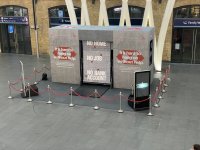- Messages
- 3,419
- Name
- Kell
- Edit My Images
- Yes
Won't go into specifics as this is for a yet-to-be-announced work thing.
But we have an area to cover which is 3.5m by 6m. We've got an image we like from Getty - it's one of the biggest images I can find at 50MP and 9158 x 5459 pixels.
We've worked out this will be about 39 DPI if used as is - without extending it. Printers are recommending a minimum of 72DPI for this installation.
Would using one of those programmes actually give us the DPI to make it work?
Thanks for any advice.
But we have an area to cover which is 3.5m by 6m. We've got an image we like from Getty - it's one of the biggest images I can find at 50MP and 9158 x 5459 pixels.
We've worked out this will be about 39 DPI if used as is - without extending it. Printers are recommending a minimum of 72DPI for this installation.
Would using one of those programmes actually give us the DPI to make it work?
Thanks for any advice.



